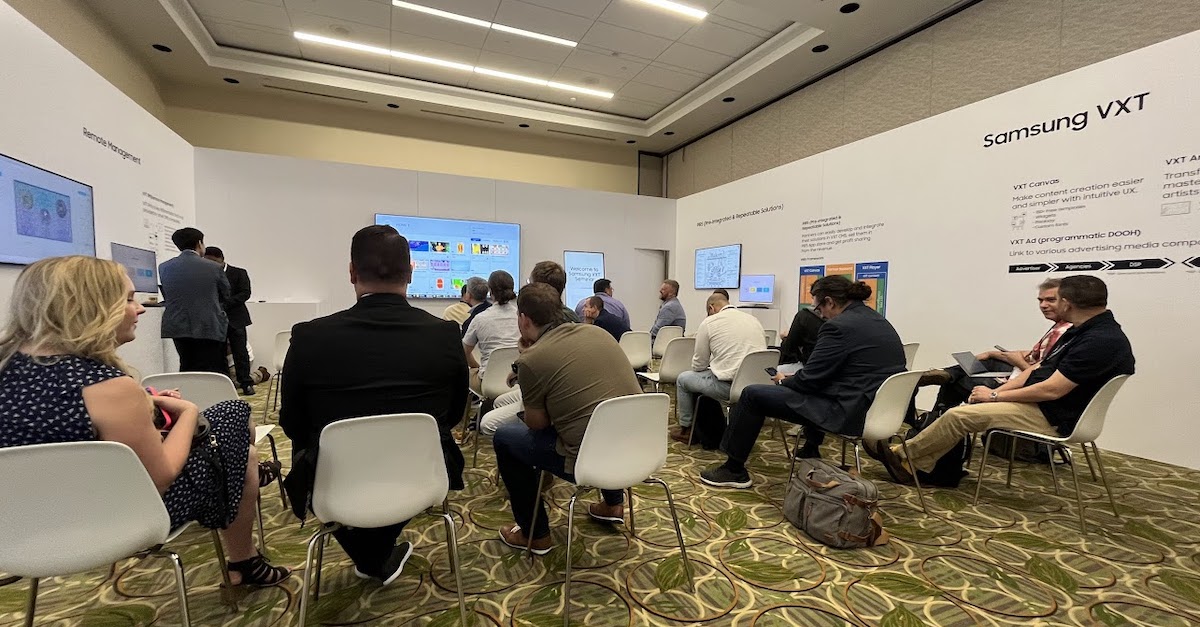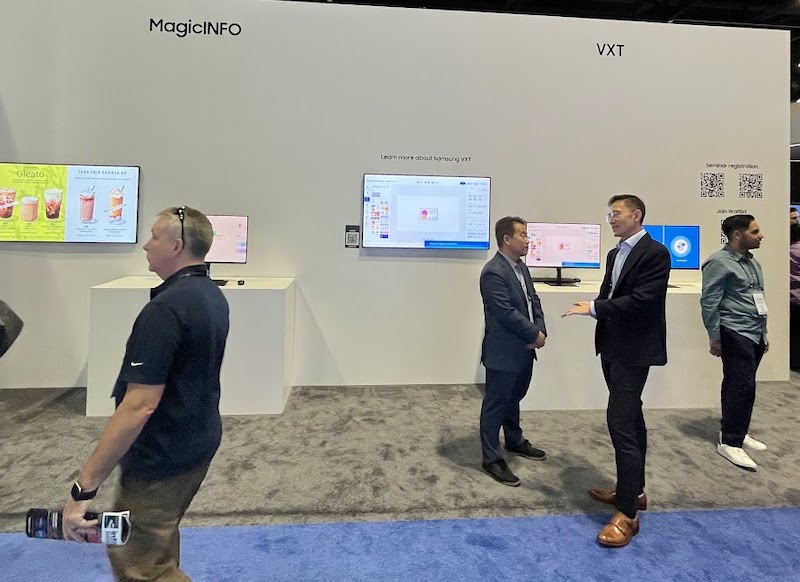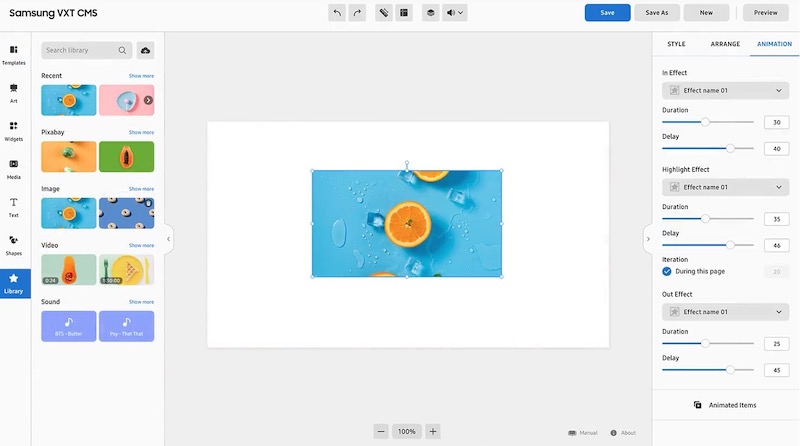
Industry “Should Be Put On Notice” With Emergence Of New VXT SaaS CMS: Samsung
June 28, 2023 by Dave Haynes
I first started hearing rumblings about Samsung developing and starting to talk about a successor to its MagicINFO CMS software at the start of the year, and got a little sense of it during ISE in Spain, and in the weeks after. The electronics giant was fully ready to showcase and talk about it by the time InfoComm rolled around a couple of weeks ago.
In short, Samsung VXT is a natively-cloud digital signage CMS platform that will gradually supplant MagicINFO in two to three years, and Samsung is opening up hardware support beyond its own operating system – positioning VXT as a fully-featured platform that other software companies can use as the foundation, adding functionality applications on top of it.
For example, a software company that is focused on something like railways and other mass transport systems could start to offer digital signage along with its other features, without having to develop a fully-featured CMS. It sounds a bit like the idea of headless CMS platforms.
The offer also includes built-in content creation via VXT Canvas and an extension of Samsung Ads, the proprietary programmatic advertising platform mainly used for TVs, into its digital signage offer.
Samsung knows this is potentially disruptive to the digital signage community and that it will piss off some software and solutions partners who have invested in things like making their own software work on Samsung’s proprietary OS smart displays. But the company is balancing that against the market opportunity and need it perceives.

During InfoComm, I caught the tail end of a presentation for partners and then had a lengthy chat with Fred Crespo, the director of solutions for Samsung and the guy charged with developing and running the go-to-market strategy and “partner enablement.”
“VXT was designed as a kind of cloud-native product,” says Crespo. “When we looked at the way the market was transitioning from traditional CMS solutions to more sophisticated cloud-based products, we were faced with an option. We could continue to evolve MagicINFO, which had evolved into a cloud version but essentially what that was, was an on-premise version of software that was fit into a cloud context … taking a legacy platform and trying to make it modern, and we were able to do that successfully. We were able to move to a multi-tenant structure, and we were able to incorporate some new feature sets.”
But that legacy code set created a lot of limitations, says Crespo, prompting Samsung to conclude it made sense to start from scratch with a fresh UI/UX design and modern toolsets, as opposed to building on an increasingly aged, limited platform that’s been around since the mid-2000s.
Now, he says, VXT and MagicINFO will be parallel solutions in the market, with MagicINFO dedicated primarily towards medium-sized to enterprise customers. “Where there’s a high degree of complexity, you’ve got a need for third-party product integration, and you’ve got both an on-prem and a cloud offering that meet specific needs.”
“But the long term aspiration is to fold everything into VXT,” adds Crespo. “In order for that to happen, VXT needs to grow up. It’s got to meet MagicINFO from a feature parity standpoint. And we’ve got to be able to migrate legacy MagicINFO customers gracefully into VXT. Until those things happen, we’re not end-of-life’ing MagicINFO in our timeline.”
He says MagicINFO will likely go away in two to three years, but support will continue beyond that. However, there is no new development being done on it, apart from bug fixes. “Essentially, it’s a frozen product. All net-new development is happening on VXT.”
Software is being worked on in Poland, India, Mexico and in Korea.
Crespo says the cloud native capabilities make it possible to broaden hardware and software support. “So we’re now able to think of it as an Android application or a Windows application or a Linux application that is not married to Tizen OS, and not married to Samsung hardware,” he says. “That’s a massive departure for us. From a strategy standpoint, we’re really looking at VXT as a platform-enabler that allows us to extend beyond our present hardware confines.”
“Usability was another big, big benefit, and we were able to design a product that’s simple to use, simple to operate. And simple to transact. From a partner standpoint, it was really important for us to make sure that the user experience and the customer journey was really pleasant,” he says, noting the admittedly clunky process of spinning up an instance of a MagicINFO set-up is being replaced by one-click license procurement and simple device provisioning with VXT.
“We’re still leveraging our reseller channel partner relationship right now, but I think it’s fair to say that looking forward, we see a world where it makes a lot of sense to transact directly for business,” says Crespo. “But again, that’s a long time down the road for us that would result in a pretty disruptive departure to how we go to market today with our other solutions. So we’re in the process of evaluating that approach, and making sure that whatever we we determine is harmonized against our present business.”
VXT also bolts on Samsung Ads. “Now, if I have a display that I can monetize with programmatic advertising, it changes how I can consider this investment. Because I’m looking at a payback period, not just a CapEx implementation. And that changes the relationship that a customer has with their reseller partner, because now their reseller partner becomes much more qualitative in that discussion.”
Programmatic’s nomenclature and pitches leave me cross-eyed, but the short story here is that Samsung has developed its own mediation layer that allows displays to connect to a buy-sell ad inventory platform, and put available time on displays up for auction.
Crespo says VXT also factors anticipated demands and trends like “green signage” via an energy management solution. “We can now harvest power consumption of all of the displays, and be able to provide predictive kind of set points to allow the the operating environment to manage in a much more power-efficient way. We’re seeing legislation coming down the pipe that may mandate that type of capability. So we want to get ahead of that curve,” he says. “Because we are a global platform, we also want to be globally relevant in every market, right. And this is something that in Europe, for example, they’re much more stringent on power consumption. So we want to be relevant in that space. Let’s bring that into the US. And let’s see how we leverage that.”

Samsung is positioning VXT as a foundational platform that other software solutions companies, directly or indirectly in digital signage and DOOH, can build on top of with full or very specific functions, using the example of smart device apps.
“Think about it this way … when Apple launched the iPhone, what they launched was not so much a phone as they launched an app store concept and ecosystem. And that ecosystem required developers to take a look at that, and decide whether or not they’re going to spend precious development cycles in developing what’s called now an app, ahead of there being a market demand for that app.”
“Look at it now. The app-ification of everything has really taken a hold. And it’s second nature to us to just have an app for specific functions. We see digital signage in the same way, where we used to have a focus on API integration with Tizen OS development that allowed you to run your entire stack of solution on our display, without using a media player in between.”
With VXT, he says, software companies and solutions providers can focus on a la carte, specialized functionality apps – airport FIDS for example – as opposed to developing and supporting an expensive “all-you-can-eat” fully-featured platform that buyers don’t necessarily want or need … want to pay a lot of money for …
“We’re saying, move away from that and create widgetized, component-ized applications that sell your solution or your capability based on specific functions, whether it’s IPTV, whether it’s digital menu board integration, whether it’s third-party data integration to other systems, like real estate systems, or car dealerships. The vertical opportunities really become endless at that point.”
The base VXT SaaS offer is $12/month per license, and then there is a pro version that Crespo didn’t yet have a price on. The latter has attributes like full energy management, device management, more scale for control and provisioning. The base version is a bit like a gateway product, with the intent of graduating a high percentage of those users into the Pro version as they grow. But the base model is important because the early target market is SMBs – the onesie-twosie jobs versus enterprise opportunities.
There are free trial accounts right now for the base platform and the Pro version is launching in early October.
I asked what the industry response has been, given how Samsung has evolved from a display manufacturer that actively courted software and solutions partners to use its screens and develop to the Samsung smart signage platform. Samsung has arguably been a direct competitor for many years via MagicINFO, but that software wasn’t widely regarded as serious competition … more like something sSamsung made available. Now other software companies are looking at a modern, newly-built SaaS CMS with full device management and even a ready-to-go, built-in ad module. And it is cost-competitive with the lower-tier of the market, though there are certainly companies closing SaaS license deals at less than $12/month.
“We’re receiving all of the usual responses you get when you’re launching something that’s disruptive,” says Crespo. “We’re shaking up the CMS market space, for sure. So I think what we’ve seen is that there’s quite a bit of, I don’t know how to say this without sounding partially arrogant, but you know, we’re Samsung. And we bring a lot. There’s a bully pulpit to what we do to some degree. So we’re also trained to be somewhat humble about it.”
“But the reality is that our market heft, our marketing prowess, our developer network, our reseller network, they’re second to none. And we’re leveraging all of that behind this product,” he says. “So everyone should be put on notice.”



So, if I understand this correctly, Samsung is literally killing Tizen and MagicInfo over 2-3 years. The question arises: Why would anyone sell a dead platform? Of course, my underlying question is why did anyone develop for and sell 6 generations of orphan OSs and CMSs in the first place?
MagicINFO Is going away but Samsung says Tizen is not … but they’ve realized a proprietary OS as the only option was/is problematic … they already opened up the Samsung Kiosk to support Windows
If I was still blogging, this would be worth 2,000 words easily. But it might have a slightly snarkier tone.
Cliff’s Notes version: let’s pee down the necks of software partners, integrators and ad platforms and tell them its raining. Let’s say we’ve created an application ecosystem and position ourselves as a trusted partner with serious software chops, led by an industry veteran of 11 months. Oh, wait… give us 2-3 years to put the finishing touches on. Let’s tell everyone they are on notice, just like they were with MagicInfo and Tizen. And let’s do it all with a critical leadership position open: https://www.linkedin.com/jobs/view/3649571328
That noise you hear just might be their partner network flocking to providers with open environments.